|
(Web
note: Scroll down for transcribed text)
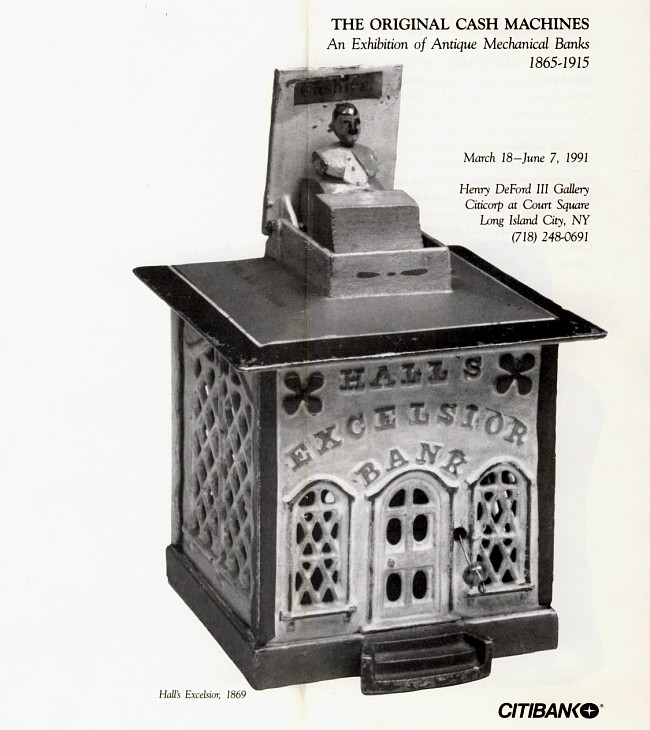
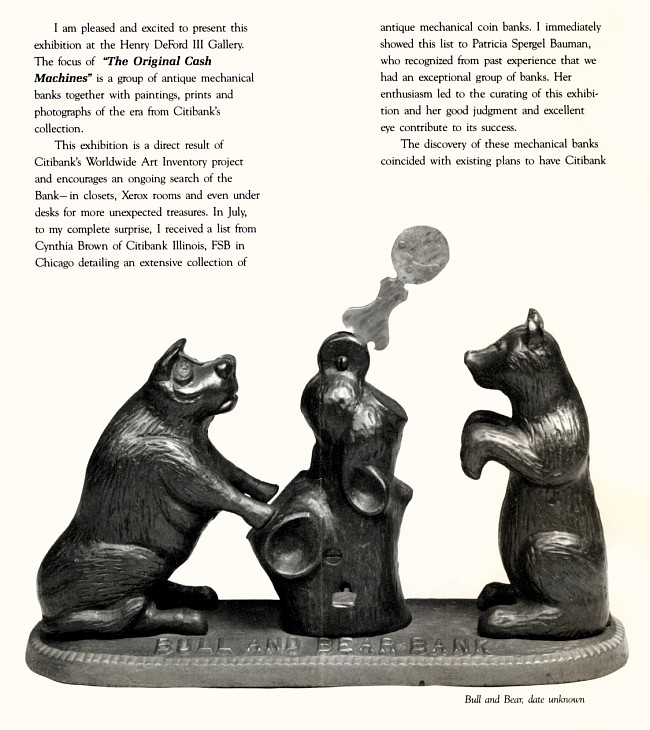
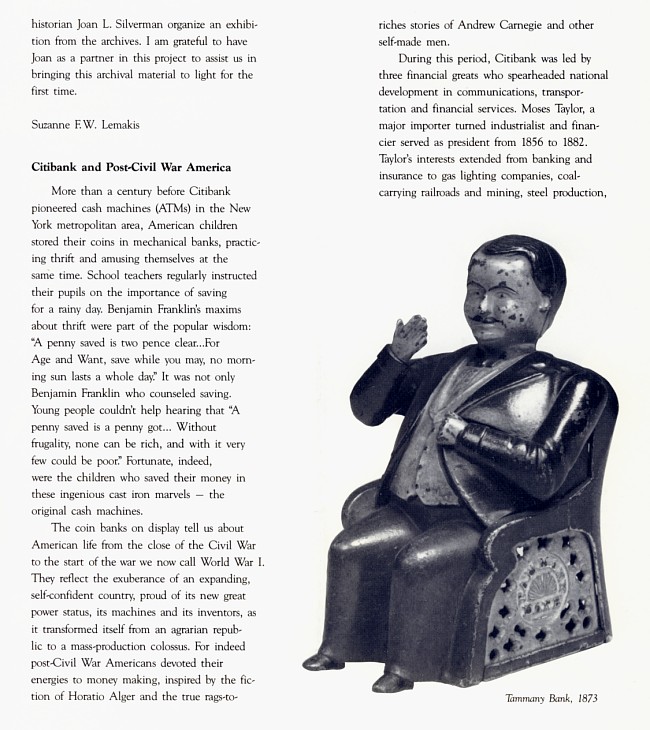
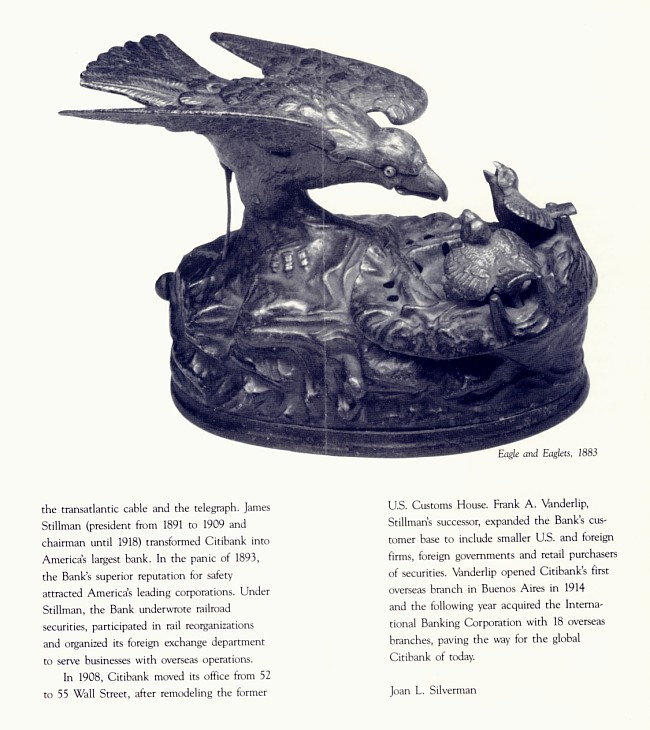
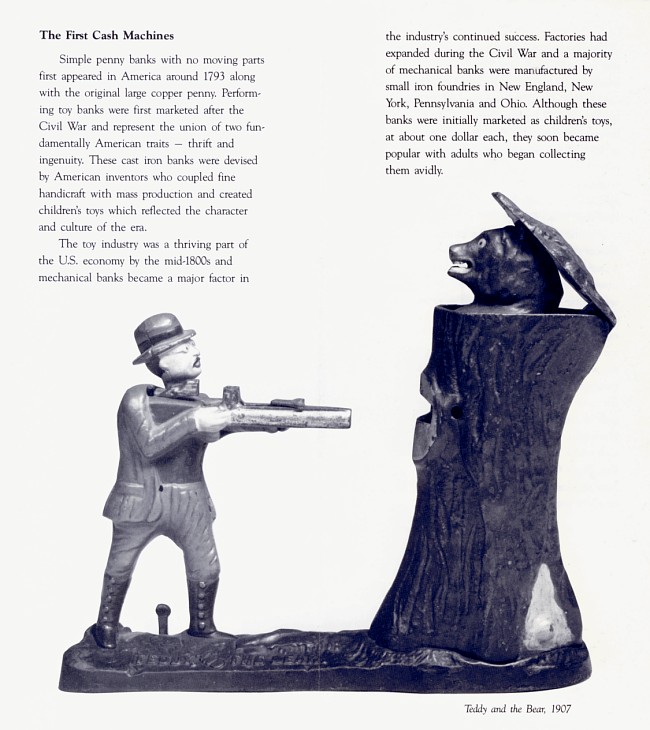
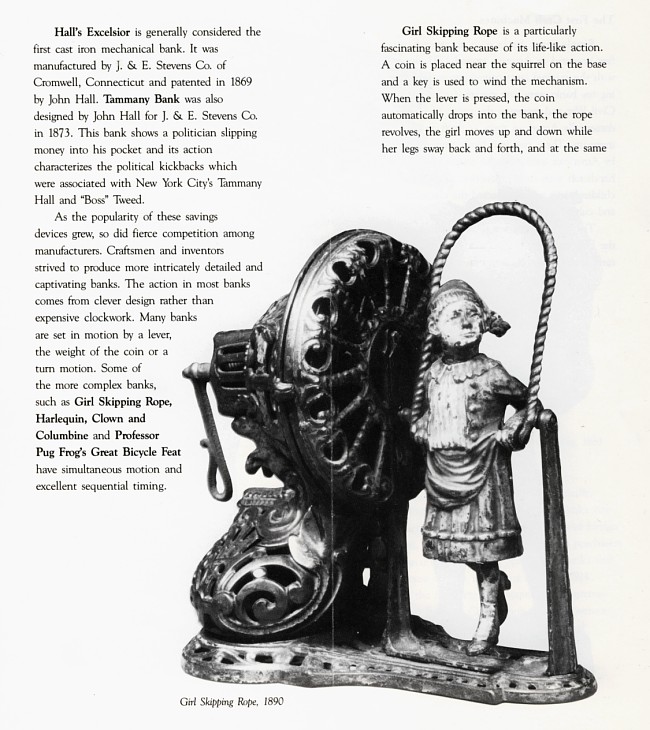
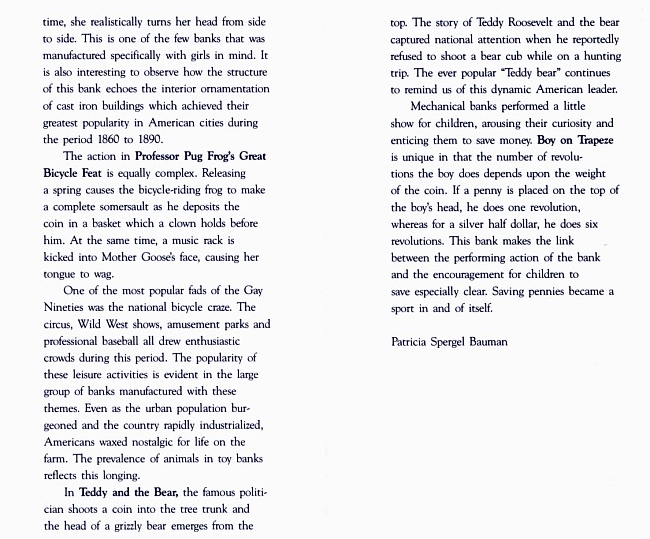
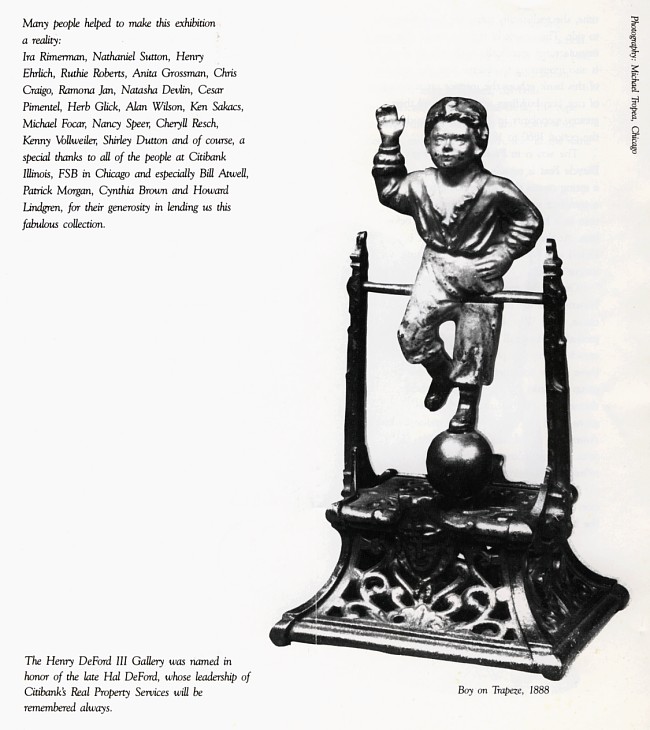
THE ORIGINAL CASH MACHINES
An Exhibition of Antique Mechanical
Banks
1865-1915
March 18 — June 7, 1991
Henry DeFord III Gallery
Citicorp at Court Square
Long Island City, NY
(718) 248-0691
I am pleased and excited to present this exhibition at the Henry DeFord
III Gallery. The focus of "The Original Cash Machines" is a
group of antique mechanical banks together with paintings, prints and
photographs of the era from Citibank's collection.
This exhibition is a direct result of Citibank's Worldwide Art
Inventory project and encourages an ongoing search of the Bank — in closets,
Xerox rooms and even under desks for more unexpected treasures. In July, to
my complete surprise, I received a list from Cynthia Brown of Citibank
Illinois, FSB in Chicago detailing an extensive collection of mechanical
coin banks. I immediately showed this list to Patricia Spergel Bauman, who
recognized from past experience that we had an exceptional group of banks.
Her enthusiasm let to the curating of this exhibition and her good judgment
and excellent eye contribute to its success.
The discovery of these mechanical banks coincided with existing plans
to have Citibank historian Joan L. Silverman organize an exhibition from the
archives. I am grateful to have Joan as a partner in this project to assist
us in bringing this archival material to light for the first time.
Suzanne F.W. Lemakis
Citibank and Post-Civil War America
More than a century before Citibank pioneered cash machines
(ATMs) in the New York metropolitan area, American children stored their
coins in mechanical banks, practicing thrift and amusing themselves at the
same time. School teachers regularly instructed their pupils on the
importance of saving for a rainy day. Benjamin Franklin's maxims about
thrift were part of the popular wisdom: "A penny saved is two pence clear...
For Age and Want, save while you may, no morning sun lasts a whole day." It
was not only Benjamin Franklin who counseled saving. Young people couldn't
help hearing that "A penny saved is a penny got... Without frugality, none
can be rich, and with it very few could be poor." Fortunate, indeed, were
the children who saved their money in these ingenious cast iron marvels —
the original cash machines.
The coin banks on display tell us about American life from the close of
the Civil War to the start of the war we now call World War I. They reflect
the exuberance of an expanding, self-confident country, proud of its new
great power status, its machines and its inventors, as it transformed itself
from an agrarian republic to a mass-production colossus. For indeed
post-Civil War Americans devoted their energies to money making, inspired by
the fiction of Horatio Alger and the true rags-to-riches stories of Andrew
Carnegie and other self-made men.
During this period, Citibank was led by three financial greats who
spearheaded national development in communications, transportation and
financial services. Moses Taylor, a major importer turned industrialist and
financier served as president from 1856 to 1882. Taylor's interests extended
from banking and insurance to gas lighting companies, coal-carrying
railroads and mining, steel production, the transatlantic cable and
telegraph. James Stillman (president from 1891 to 1909 and chairman until
1918) transformed Citibank into America's largest bank. In the panic of
1883. the Bank's superior reputation for safety attracted America's leading
corporations. Under Stillman, the Bank underwrote railroad securities,
participated in rail reorganizations and organized its foreign exchange
department to serve businesses with overseas operations.
In 1908, Citibank moved its office from 52 to 55 Wall Street, after
remodeling the former U.S. Customs House. Frank A. Vanderlip, Stillman's
successor, expanded the Bank's customer base to include smaller U.S. and
foreign firms, foreign governments and retail purchasers of securities.
Vanderlip opened Citibank's first overseas branch in Buenos Aires in 1914
and the following year acquired the International Banking Corporation with
18 overseas branches, paving the way for the global Citibank of today.
Joan L. Silverman
The First Cash Machines
Simple penny banks with no moving parts first appeared in America
around 1793 along with the original large copper penny. Performing toy banks
were first marketed after the Civil War and represent the union of two
fundamentally American traits — thrift and ingenuity. These cast iron banks
were devised by American inventors who coupled fine handicraft with mass
production and created children's toys which reflected the character and
culture of the era.
The toy industry was a thriving part of the U.S. economy by the
mid-1800s and mechanical banks became a major factor in the industry's
continued success. Factories had expanded during the Civil War and a
majority of mechanical banks were manufactured by small iron foundries in
New England, New York, Pennsylvania and Ohio. Although these banks were
initially marketed as children's toys, at about one dollar each, they soon
became popular with adults who began collecting them avidly.
Hall's Excelsior is generally considered the first
cast iron mechanical bank. It was manufactured by J. & E. Stevens Co. of
Cromwell, Connecticut and patented in 1869 by John Hall. Tammany
Bank was also designed by John Hall for J. & E. Stevens Co. in
1873. This bank shows a politician slipping money into his pocket and its
action characterizes the political kickbacks which were associated with New
York's Tammany Hall and "Boss" Tweed.
As the popularity of these savings devices grew, so did fierce
competition among manufacturers. Craftsmen and inventors strived to produce
more intricately detailed and captivating banks. The action in most banks
comes from clever design rather than expensive clockwork. Many banks are set
in motion by a lever, the weight of the coin or a turn motion. Some of the
more complex banks, such as Girl Skipping Rope, Harlequin, Clown and
Columbine and Professor Pug Frog's Great Bicycle Feat
have simultaneous motion and excellent sequential timing.
Girl Skipping Rope is a particularly fascinating bank
because of its life-like action. A coin is placed near the squirrel on the
base and a key is used to wind the mechanism. When the lever is pressed, the
coin automatically drops into the bank, the rope revolves, the girl moves up
and down while her legs sway back and forth, and at the same time, she
realistically turns her head from side to side. This is one of the few banks
that was manufactured specifically with girls in mind. It is also
interesting to observe how the structure of this bank echoes the interior
ornamentation of cast iron buildings which achieved their greatest
popularity in American cities during the period 1860 to 1890.
The action in Professor Pug Frog's Great Bicycle Feat
is equally complex. Releasing a spring causes the bicycle-riding frog to
make a complete somersault as he deposits the coin in a basket which a clown
holds before him. At the same time, a music rack is kicked into Mother
Goose's face, causing her tongue to wag.
One of the most popular fads of the Gay Nineties was the national
bicycle craze. The circus. Wild West shows, amusement parks and professional
baseball all drew enthusiastic crowds during this period. The popularity of
these leisure activities is evident in the large group of banks manufactured
with these themes. Even as the urban population burgeoned and the country
rapidly industrialized, Americans waxed nostalgic for life on the farm. The
prevalence of animals in toy banks reflects this longing.
In Teddy and the Bear, the famous politician shoots a
coin into the tree trunk and the head of a grizzly bear emerges from the
top. The story of Teddy Roosevelt and the bear captured national attention
when he reportedly refused to shoot a bear cub while on a hunting trip. The
ever popular "Teddy bear" continues to remind us of this dynamic American
leader.
Mechanical banks performed a little show for children, arousing their
curiosity and enticing them to save money. Boy on Trapeze
is unique in that the number of revolutions the boy does depends upon the
weight of the coin. If a penny is placed on the top of the boy's head, he
does one revolution, whereas for a silver half dollar, he does six
revolutions. This bank makes the link between performing action of the bank
and the encouragement for children to save especially clear. Saving pennies
became a sport in and of itself.
Patricia Spergel Bauman
Many people helped to make this exhibition a reality:
Ira Rimerman, Nathaniel Sutton, Henry Ehrlich, Ruthie Roberts, Anita
Grossman, Chris Craigo, Ramona Jan, Natasha Devlin, Cesar Pimentel, Herb
Glick, Alan Wilson, Ken Sakacs, Michael Focar, Nancy Speer, Cheryll Resch,
Kenny Vollweiler, Shirley Dutton and of course, a special thanks to all of
the people at Citibank Illinois, FSB in Chicago and especially Bill Atwell,
Patrick Morgan, Cynthia Brown and Howard Lindgren, for their generosity in
lending us this fabulous collection.
The Henry FeFord III Gallery was named in honor of the late Hal DeFord,
whose leadership of Citibank's Real Property Services will be remembered
always.
Photography: Michael Tropea, Chicago
Hall's Excelsior, 1869
Bull and Bear, date unknown
Tammany Bank, 1873
Eagle and Eaglets, 1883
Teddy and the Bear, 1907
Girl Skipping Rope, 1890
|